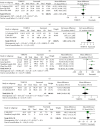Comparison of Transnasal Humidified Rapid-Insufflation Ventilatory Exchange and Facemasks in Preoxygenation: A Systematic Review and Meta-Analysis
- PMID: 35872871
- PMCID: PMC9300319
- DOI: 10.1155/2022/9858820
Comparison of Transnasal Humidified Rapid-Insufflation Ventilatory Exchange and Facemasks in Preoxygenation: A Systematic Review and Meta-Analysis
Abstract
Background: Transnasal Humidified Rapid-Insufflation Ventilatory Exchange (THRIVE) has received increasing attention and application as an effective noninvasive mode of ventilation in the treatment of clinical anesthesia and critically ill patients. The conclusions reached in clinical studies of THRIVE and facemask oxygenation are still controversial, and the main objective of this systematic review is to determine the advantages of THRIVE over facemask oxygenation in intensive care units, respiratory medicine, and perioperative preoxygenation.
Methods: PubMed, Embase, Web of Science, and Cochrane Library have search restrictions. The search library was full of English language articles from the first publication to 15 July 2021. Eligible randomized controlled study designs were included. 245 records were screened, and 5 studies met the inclusion criteria, enrolling a total of 235 patients.
Results: Studying the THRIVE group compared to the facemask group, three studies analyzing intubation time showed that there is no difference in the effect of THRIVE and facemasks (MD -1.22, 95% CI -7.23 to 4.78, and P = 0.69 > 0.05). Three studies analyzing apnea showed that there was no difference between the two groups (SMD 1, 95% CI -0.76 to 2.76, and P = 0.27 > 0.05). Three studies analyzing PaO2 after preoxygenation showed that THRIVE is more effective than facemasks (MD 72.58, 95% CI 31.25 to 113.90, Z = 3.44, and P < 0.001). Two studies analyzing oxygen saturation SpO2 after successful intubation showed that there was no difference in the effectiveness (MD 0.09, 95% CI -1.03 to 1.22, and P = 0.87 > 0.05). Two studies analyzing PCO2 after complete paralysis or intubation preoxygenation showed that there was no difference between the two groups (MD 2.76, 95% CI -1.74 to 7.26, and P = 0.23 > 0.05).
Conclusions: THRIVE does not have a greater advantage over a facemask in improving apnea time, oxygenation time, PCO2, and SpO2, but it has an advantage in improving arterial partial pressure of oxygen (PaO2) after preoxygenation, which can improve PaO2 well. This trial is registered with the protocol registration number CRD42021268143.
Copyright © 2022 Yongkai Li and Jianzhong Yang.
Conflict of interest statement
The authors declare no conflicts of interest.
Figures



Similar articles
-
Heliox for croup in children.Cochrane Database Syst Rev. 2021 Aug 16;8(8):CD006822. doi: 10.1002/14651858.CD006822.pub6. Cochrane Database Syst Rev. 2021. PMID: 34397099 Free PMC article.
-
Positioning for acute respiratory distress in hospitalised infants and children.Cochrane Database Syst Rev. 2022 Jun 6;6(6):CD003645. doi: 10.1002/14651858.CD003645.pub4. Cochrane Database Syst Rev. 2022. PMID: 35661343 Free PMC article.
-
Initial arch wires used in orthodontic treatment with fixed appliances.Cochrane Database Syst Rev. 2018 Jul 31;7(7):CD007859. doi: 10.1002/14651858.CD007859.pub4. Cochrane Database Syst Rev. 2018. Update in: Cochrane Database Syst Rev. 2024 Feb 06;2:CD007859. doi: 10.1002/14651858.CD007859.pub5. PMID: 30064155 Free PMC article. Updated.
-
Negative pressure wound therapy for open traumatic wounds.Cochrane Database Syst Rev. 2018 Jul 3;7(7):CD012522. doi: 10.1002/14651858.CD012522.pub2. Cochrane Database Syst Rev. 2018. PMID: 29969521 Free PMC article.
-
Sertindole for schizophrenia.Cochrane Database Syst Rev. 2005 Jul 20;2005(3):CD001715. doi: 10.1002/14651858.CD001715.pub2. Cochrane Database Syst Rev. 2005. PMID: 16034864 Free PMC article.
Cited by
-
High-Flow Nasal Oxygen versus Conventional Nasal Cannula in Preventing Hypoxemia in Elderly Patients Undergoing Gastroscopy with Sedation: A Randomized Controlled Trial.Int J Med Sci. 2024 Mar 25;21(5):914-920. doi: 10.7150/ijms.91607. eCollection 2024. Int J Med Sci. 2024. PMID: 38617012 Free PMC article. Clinical Trial.
-
Pre-oxygenation with high-flow oxygen through the nasopharyngeal airway compared to facemask on carbon dioxide clearance in emergency adults: a prospective randomized non-blinded clinical trial.Eur J Trauma Emerg Surg. 2024 Jun;50(3):1051-1061. doi: 10.1007/s00068-023-02418-2. Epub 2023 Dec 26. Eur J Trauma Emerg Surg. 2024. PMID: 38148421 Free PMC article. Clinical Trial.
-
The comparison of preoxygenation methods before endotracheal intubation: a network meta-analysis of randomized trials.Front Med (Lausanne). 2024 Jun 7;11:1379369. doi: 10.3389/fmed.2024.1379369. eCollection 2024. Front Med (Lausanne). 2024. PMID: 38912343 Free PMC article.
-
[THRIVE combined with i-gel laryngeal mask for prolonging apneic oxygenation time in retrograde intrarenal surgery].Nan Fang Yi Ke Da Xue Xue Bao. 2023 Sep 20;43(9):1599-1605. doi: 10.12122/j.issn.1673-4254.2023.09.18. Nan Fang Yi Ke Da Xue Xue Bao. 2023. PMID: 37814875 Free PMC article. Clinical Trial. Chinese.
References
-
- Mir F., Patel A., Iqbal R., Cecconi M., Nouraei S. A. R. A randomised controlled trial comparing transnasal humidified rapid insufflation ventilatory exchange (THRIVE) pre-oxygenation with facemask pre-oxygenation in patients undergoing rapid sequence induction of anaesthesia. Anaesthesia . 2017;72(4):439–443. doi: 10.1111/anae.13799. - DOI - PubMed
Publication types
MeSH terms
Substances
LinkOut - more resources
Full Text Sources
Miscellaneous

